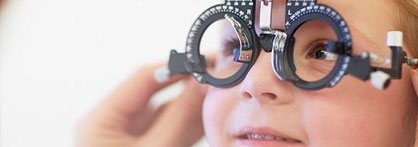Pediatric Opthalmology & Strabismus

KMC Hospital's Pediatric Opthalmology & Strabismus Treatment
The Pediatric Ophthalmology Department at KMC is a highly specialized with trained pediatric ophthalmologists who understand the unique eye care needs of children. The advanced eye care facility offers expert diagnosis and treatment for the entire gamut of ophthalmic problems in children belonging to the age groups from premature babies to teenagers. Our pediatric ophthalmologists combine the latest techniques with the good experience in the care of eye disorders in children.
One out of every 4 kids has trouble with eyesight. Often, parents don’t know there’s a problem. That’s why all children should get regular eye exams. Nearsightedness (myopia), farsightedness (hyperopia), blurry vision (astigmatism), misaligned eyes (strabismus) and lazy eyes are some of the common problems found in kids. The lesser common problems include Glaucoma, Cataract and Retinoblastoma. Kids with vision problems will show some similar behaviors. Most of the time, they squint.
- Symptom
- Risk
- Treatment
- Precautions
Your child might be having trouble with her sight if:
- Complains about headaches or blurry vision
- Closes one eye
- Rubs her eyes
- Complains about pain in one or both eyes
- Has an eye that turns in, out, up, down, or wanders
- Has eyes that cross or can’t focus
- Holds books really close to see the words
If you spot one of these symptoms, make an appointment with her pediatrician or an eye doctor. Getting a checkup right away and let the doctor find vision problems before they can affect the sight.
Over a period of time, cataracts can lead to vision loss.
Strabismus: The child’s eyes cross or don’t line up with each other, eyes that aren’t aligned. The pediatric ophthalmologist may put a patch over the stronger eye to strengthen the weaker one, or prescribe special glasses or eye exercises.
Myopia: The child has trouble seeing things far away, nearsightedness. Once the vision is checked eyeglasses or contact lenses can improve distance vision.
Hyperopia: The child can’t things close up, farsightedness. After an eye check up eyeglasses or contact lenses to help with close-up vision.
Astigmatism: Is when the child’s vision is blurry. It means the cornea of her eye is curved and can’t focus on images clearly. A thorough eye examination will help decide if eyeglasses would help.
Amblyopia: Some kids have a lazy eye which don’t have any symptoms. But the doctor should be able to spot it during a regular eye exam. He can usually correct (or improve) it if he finds and treats it early enough. The child may have to wear an eye patch on her stronger eye. It’s rare, but some kids need surgery to align their eyes.
To help protect your child’s eyesight:
- Eat right both during pregnancy and after. Your baby will be healthier and you will set a good example.
- Provide nutritious meals with fruits, vegetables, nuts, and up to 12 ounces a week of fish. These foods contain key antioxidants and nutrients such as vitamin C, vitamin, E, zinc, omega-3 fatty acids, and lutein, which are linked to eye health.
- Provide your child with age-appropriate toys that are free from sharp edges.
- Give your child toys that encourage visual development.
- Watch your baby for signs that the eyes are crossed or turned out.
- Look at your baby for any haziness or clouding in the pupil.
- Provide sun protection when outdoors by means of shelter or UV coated lenses, especially if your child’s eyes are light in color.
- Be an example to your child by wearing the proper protective athletic gear when playing sports.
- Have your child’s eyes examined regularly, particularly during infancy and childhood.
To help your baby develop good eyesight:
- Place toys within focus of your baby’s eyes, only 8 to 12 inches away.
- Encourage your baby to crawl. This helps develop hand-eye coordination.
- Talk to your baby as you move around the room to encourage his or her eyes to follow you.
- Hang a mobile above or outside of your baby’s crib.
- Give your baby toys to hold and visualize.
Make sure your baby is following moving objects with his eyes and developing eye-hand coordination. If he seems delayed, talk to your child’s doctor.
As your baby grows into an active child, continue to encourage good eyesight by providing visually stimulating toys that will improve motor and eye-hand coordination skills. Some good examples are:
- Building or linking blocks
- Puzzles
- Stringing beads
- Pegboards
- Drawing tools like pencils, chalk, crayons, and markers
- Finger paints
- Modeling clay
